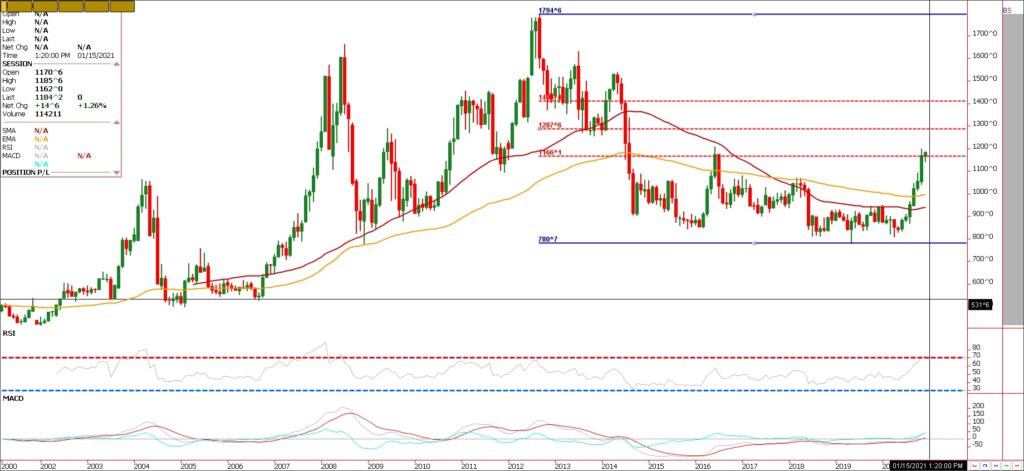Commentary:
The bean market traded lower overnight about 5 to 6 cents lower into the AM open trading down to trendline support in somewhat of a turnaround Tuesday type action. That was all prior to this morning’s NOPA (National Oilseed Processor Association ) crush data that came in at 181.0 million bushels, a million above the average trade estimate (180.0) and up from 164.9 million bushels (mbu) posted last November (the previous Nov record), though still down from the single-month record 185.2 mbu last month. Cumulative Sep-Nov crush stands at 528 mbu, already 35 mbu ahead of last year’s pace, with the USDA looking for a 30 mbu entire-year increase… Bean Oil Stocks came in at 1558 million pounds, slightly above the average trade guess and up from 1487 mln lbs last month and 1448 mln last year; domestic oil use for Nov is 2035 mln lbs, down from October but easily still a record for the month. Soybean Meal Shipments million 1.082 million short tons, up from 946k ST last month and 869k ST last year, and the largest monthly total since January 2013. Domestic meal use of 3.2 million ST is down from Oct but also still easily a monthly record tally. The aftermath of the report saw soybeans and oil tick higher post-NOPA release with meal holding on to strong session gains into the close. The USDA has continually increased crush estimates in recent S&D reports but looks like it has further yet to go in my opinion, with ending stocks for 2020/21 tightening up from all sides which includes crush, strong exports, and another potential “final” production trim in my view. It is my belief that the bullish report today validated why the bulls bought into last Thursdays crop report, that further ending stocks are coming from the demand side of the balance sheet
All of this should could end up in USDA’s January 12 quarterly grain stocks report, unless the agency surprises us with an unexpected increase in the size of the 2020 US crop. As for South America, the early indications are that Argentina will be leaning dry from now through January for core production areas, while “most” production areas of Brazil turn wetter the last 10 days of this month, through much of January. In my view it will be the weather in Argentina that could have major ramifications for corn and meal longer term. Near term upside levels in meal if the push higher continues could see 4.06, 4.25 and then 4.59. I would exit any longs in meal on a close below 3.71. Technical levels for March 21 Corn, come on a close above 4.29. If that occurs, look for the market to retest the 4.38/3 area9 and if that gets taken out the potential to rally near last year’s highs near 4.64/4.68 becomes a realistic possibility. I attached a monthly bean chart below. A fifty percent retracement from the all-time high to last year’s low is at 1288. Call me with questions on trading ideas or if you have questions. 888 391 7894 or slusk@walshtrading.com

Trade Ideas
Futures-N/A
Options-N/A
Risk/Reward
Futures-N/A
Options-N/A
Please join me for a free grain and livestock webinar every Thursday at 3pm Central. Sign up is free and a recording link will be sent upon signup. We discuss supply, demand, weather, and the charts. Sign Up Now
Walsh Trading, Inc. is registered as a Guaranteed Introducing Broker with the Commodity Futures Trading Commission and an NFA Member.
Futures and options trading involve substantial risk and is not suitable for all investors. Therefore, individuals should carefully consider their financial condition in deciding whether to trade. Option traders should be aware that the exercise of a long option will result in a futures position. The valuation of futures and options may fluctuate, and as a result, clients may lose more than their original investment. The information contained on this site is the opinion of the writer or was obtained from sources cited within the commentary. The impact on market prices due to seasonal or market cycles and current news events may already be reflected in market prices. PAST PERFORMANCE IS NOT NECESSARILY INDICATIVE OF FUTURE RESULTS.
All information, communications, publications, and reports, including this specific material, used and distributed by Walsh Trading, Inc. (“WTI”) shall be construed as a solicitation for entering into a derivatives transaction. WTI does not distribute research reports, employ research analysts, or maintain a research department as defined in CFTC Regulation 1.71.
